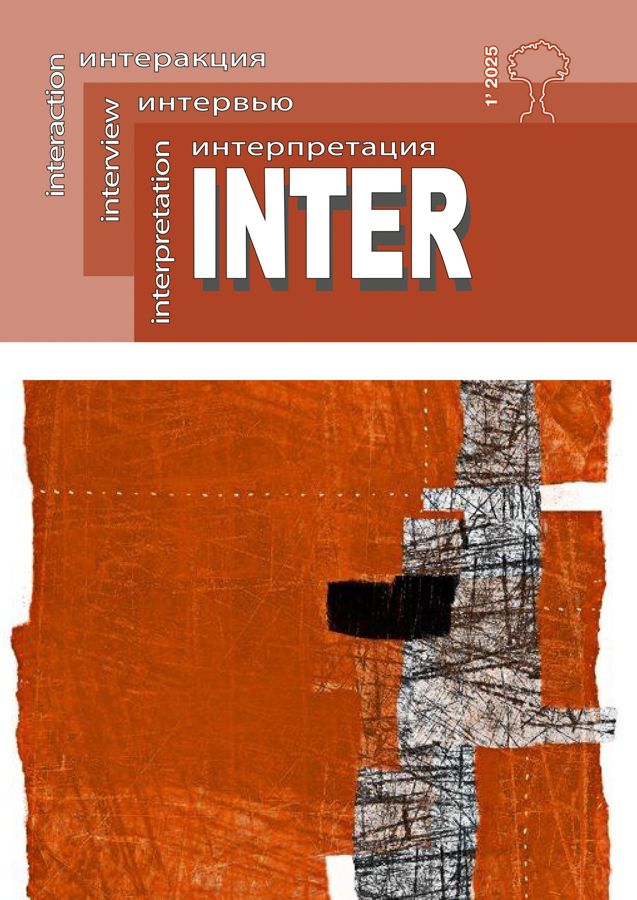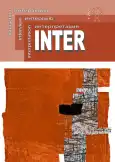Masculine Ideology and Attitudes towards Violence in the Construct of Military Identity
- Authors: Startsev S.V.1
-
Affiliations:
- HSE University
- Issue: Vol 17, No 1 (2025)
- Pages: 22-41
- Section: Theoretical Discourses and Debates
- URL: https://journal-vniispk.ru/2687-0401/article/view/289828
- DOI: https://doi.org/10.19181/inter.2025.17.1.2
- EDN: https://elibrary.ru/OXDNEK
- ID: 289828
Cite item
Full Text
Abstract
About the authors
Sergey Vyacheslavovich Startsev
HSE University
Email: sstartsev@hse.ru
ORCID iD: 0000-0001-8152-1817
Graduate Student, Social Institutes Analysis Department, School of Sociology, Faculty of Social Sciences Moscow, Russia
References
- Брубейкер Р., Купер Ф., Кучерова Д., Семенова А., Могильнер М. За пределами «идентичности» // Ab Imperio. 2002. № 3. С. 61–115.
- Волков В. Силовое предпринимательство. СПб.: Летний сад, 2002. EDN: SOSLWY
- Жирар Р. Завершить Клаузевица. Беседы с Бенуа Шантром. М.: ББИ, 2019.
- Манн М. Фашисты. СПб.: Питер, 2023.
- Мосс М. Техники тела // Общества. Обмен. Личность. Труды по социальной антропологии. М.: Восточная литература, 1996. С. 242–250.
- Рикер П. Я-сам как другой. М.: Издательство гуманитарной литературы, 2008. EDN: TSPVDN
- Старцев С.В. Интер-энциклопедия: метод картографирования телесности // Интеракция. Интервью. Интерпретация. 2022. Т. 14. № 4. С. 110–125. DOI: https://doi.org/10.19181/inter.2022.14.4.6 EDN: UIMIGI
- Старцев С.В. Анализ установок исследователя в процессе изучения сензитивных тем: опыт интервьюирования участников военных конфликтов // Социологический журнал. 2024. Т. 30. № 3. С. 61–75. DOI: https://doi.org/10.19181/socjour.2024.30.3.3 EDN: HEUFQL
- Старцев С.В. Между идентификацией и профессионализацией: оптики социологического рассмотрения военнослужащих // Laboratorium: Журнал социальных исследований. 2024. Т. 16. № 1. С. 75–99. DOI https://doi.org/10.25285/2078-1938-2024-16-1-75-99
- Artemova O.Y. (2020) Equality as a Human Categorical Imperative. Prehistoric Archaeology Journal of Interdisciplinary Studies. No. 1. P. 64–91. DOI: https://doi.org/10.31600/2658-3925-2020-1-64-91
- Ashcroft L. (2014) The Veterans’ Transition Review. URL: https://www.veteranswales.co.uk/images/ASHCROFT-TRANSITION-REVIEW-2014.pdf (дата обращения: 10.01.2025)
- Boehm C., Boehm C. (2009) Hierarchy in the Forest: The Evolution of Egalitarian Behavior. Cambridge: Harvard University Press.
- Bösl E. (2013) “An Unbroken Man Despite Losing an Arm”: Corporeal Reconstruction and Embodied Difference—Prosthetics in Western Germany after the Second World War (c. 1945–1960). War and the Body. London: Routledge. P. 167–180.
- Bulmer S., Eichler M. (2017) Unmaking Militarized Masculinity: Veterans and the Project of Military-to-Civilian Transition. Critical Military Studies. Vol. 3. No. 2. P. 161–181. DOI: https://doi.org/10.1080/23337486.2016.1180609
- Carroll W.K., Ratner R.S. (1996) Master Framing and Cross-Movement Networking in Contemporary Social Movements. The Sociological Quarterly. Vol. 37. No. 4. P. 601–625. DOI: https://doi.org/10.1111/j.1533-8525.1996.tb01755.x
- Cohen D. (2001) The War Come Home: Disabled Veterans in Britain and Germany, 1914–1939. Berkeley: University of California Press.
- Collins R. (2009) The Micro-Sociology of Violence. British Journal of Sociology. Vol. 60. No. 3. P. 566–576. DOI: https://doi.org/10.1111/j.1468-4446.2009.01256.x
- Connell R. (2005) Masculinities (2nd ed.). Cambridge: Polity Press.
- Crossley N. (2012) Phenomenology and the Body. In: Routledge Handbook of Body Studies. London: Routledge. P. 142–155.
- Edele M. (2008) Soviet Veterans of the Second World War: A Popular Movement in an Authoritarian Society, 1941–1991. Oxford: OUP Oxford.
- Elsrud T. (2006) Gender Creation in Travelling, or the Art of Transforming an Adventuress. In: Tourism Consumption and Representation: Narratives of Place and Self. Wallingford: CABI. P. 178–195. DOI: https://doi.org/10.1079/9780851996783.0178
- Freud S. (2015) Why War? In: Conflict After the Cold War. Abingdon: Routledge. P. 185–192.
- Fried M.H. (1960) On the Evolution of Social Stratification and the State. Indianapolis: Bobbs-Merrill. P. 713–731.
- Gastaldo R.A., Neveling J., Geissman J.W., Kamo S.L., Looy C.V. (2022) A Tale of Two Tweefonteins: What Physical Correlation, Geochronology, Magnetic Polarity Stratigraphy, and Palynology Reveal About the End-Permian Terrestrial Extinction Paradigm in South Africa. GSA Bulletin. Vol. 134. No. 3–4. P. 691–721. DOI: https://doi.org/10.1130/B35830.1
- Geertz C. (1992) Common Sense as a Cultural System. The Antioch Review. Vol. 50. No. 1/2. P. 221–241. DOI: https://doi.org/10.2307/4612512
- Godelier M. (1971) Myth and History. New Left Review. No. 69. P. 93–112.
- Goodley H. (2022) What Does It Mean to Be a Soldier?: Negotiating Identities in the British Army. London: King’s College.
- Higate P. (2000) Ex‐Servicemen on the Road: Travel and Homelessness. The Sociological Review. Vol. 48. No. 3. P. 331–347. DOI: https://doi.org/10.1111/1467-954X.00219
- Holt D.B., Thompson C.J. (2004) Man-of-Action Heroes: The Pursuit of Heroic Masculinity in Everyday Consumption. Journal of Consumer Research. Vol. 31. No. 2. P. 425–440. DOI: https://doi.org/10.1086/422120
- Hunt S. (2007) Master Status. In: The Blackwell Encyclopedia of Sociology. Malden: Wiley-Blackwell.
- Jager A.D., Tewson A., Ludlow B., Boydell K. (2016) Embodied Ways of Storying the Self: A Systematic Review of Body-Mapping. Forum Qualitative Sozialforschung Forum: Qualitative Social Research. Vol. 17. No. 2. P. 1–31. DOI: https://doi.org/10.17169/fqs-17.2.2526
- Joas H., Knöbl W. (2012) War in Social Thought: Hobbes to the Present. Princeton: Princeton University Press.
- Kang S.K., Bodenhausen G.V. (2015) Multiple Identities in Social Perception and Interaction: Challenges and Opportunities. Annual Review of Psychology. Vol. 66. No. 1. P. 547–574. DOI: https://doi.org/10.1146/annurev-psych-010814-015025
- Knauft B.M., Abler T.S., Betzig L., Boehm C., Dentan R.K., Kiefer T.M., Rodseth L. (1991) Violence and Sociality in Human Evolution [and Comments and Replies]. Current Anthropology. Vol. 32. No. 4. P. 391–428. DOI: https://doi.org/10.1086/203975
- Lee R.M. (1993) Doing Research on Sensitive Topics. London: Sage.
- Lutz C. (2006) Making War at Home in the United States: Militarization and the Current Crisis. In: The Anthropology of the State: A Reader. Malden: Blackwell Publishing. P. 291–309.
- Malešević S. (2010) How Pacifist Were the Founding Fathers?: War and Violence in Classical Sociology. European Journal of Social Theory. Vol. 13. No. 2. P. 193–212. DOI: https://doi.org/10.1177/1368431010362298
- McAleer K. (1997) Dueling: The Cult of Honor in Fin-de-Siecle Germany. Princeton: Princeton University Press.
- McBrinn J. (2018) “The Work of Masculine Fingers”: The Disabled Soldiers’ Embroidery Industry, 1918–1955. Journal of Design History. Vol. 31. No. 1. P. 1–23. DOI: https://doi.org/10.1093/jdh/epw043
- Mik‐Meyer N. (2015) Gender and Disability: Feminizing Male Employees with Visible Impairments in Danish Work Organizations. Gender, Work & Organization. Vol. 22. No. 6. P. 579–595. DOI: https://doi.org/10.1111/gwao.12107
- Mosse G.L. (1990) Fallen Soldiers: Reshaping the Memory of the World Wars. New York: Oxford University Press.
- Mosse G.L. (1998) The Image of Man: The Creation of Modern Masculinity. New York: Oxford University Press.
- Mosse G.L. (2000) Shell-Shock as a Social Disease. Journal of Contemporary History. Vol. 35. No. 1. P. 101–108. DOI: https://doi.org/10.1177/002200940003500109
- Reiss M. (2012) The Importance of Being Men: The Afrika-Korps in American Captivity. Journal of Social History. Vol. 46. No. 1. P. 23–47. DOI: https://doi.org/10.2307/41678974
- Reynolds J.M. (2017) “I’d Rather Be Dead Than Disabled”—The Ableist Conflation and the Meanings of Disability. Review of Communication. Vol. 17. No. 3. P. 149–163. DOI: https://doi.org/10.1080/15358593.2017.1331255
- Richardson L. (1990) Narrative and Sociology. Journal of Contemporary Ethnography. Vol. 19. No. 1. P. 116–135. DOI: https://doi.org/10.1177/089124190019001006
- Ricoeur P. (2002) Life in Quest of Narrative. In: On Paul Ricoeur. London; New York: Routledge. P. 34–47. DOI: https://doi.org/10.4324/9780203416815-5
- Roccas S., Brewer M.B. (2002) Social Identity Complexity. Personality and Social Psychology Review. Vol. 6. No. 2. P. 88–106. DOI: https://doi.org/10.1207/S15327957PSPR0602_01
- Salvante M. (2020) The Wounded Male Body: Masculinity and Disability in Wartime and Post-WWI Italy. Journal of Social History. Vol. 53. No. 3. P. 644–666. DOI: https://doi.org/10.1093/jsh/shz127
- Schütz A. (1945) The Homecomer. American Journal of Sociology. Vol. 50. No. 5. P. 369–376. DOI: https://doi.org/10.1086/219654
- Shils E.A., Janowitz M. (1948) Cohesion and Disintegration in the Wehrmacht in World War II. Public Opinion Quarterly. Vol. 12. No. 2. P. 280–315. DOI: https://doi.org/10.1086/265951
- Snow D.A., McAdam D. (2000) Identity Work Processes in the Context of Social Movements: Clarifying the Identity/Movement Nexus. In: Self, Identity, and Social Movements. Minneapolis: University of Minnesota Press. P. 41–67.
- Struk J. (2020) Private Pictures: Soldiers’ Inside View of War. New York: Routledge.
- Stryker S., Owens T.J., White R.W. (eds.) (2000) Self, Identity, and Social Movements. Minneapolis; London: University of Minnesota Press.
- Tavory I. (2019) Summoned: Identification and Religious Life in a Jewish Neighborhood. Chicago: University of Chicago Press.
- Van Stekelenburg J. (2013) Collective Identity. In: The Wiley-Blackwell Encyclopedia of Social and Political Movements. Oxford: Wiley‐Blackwell. P. 219–225. DOI: https://doi.org/10.1002/9780470674871.wbespm039
- Wacquant L. (2015) For a Sociology of Flesh and Blood. Qualitative Sociology. Vol. 38. P. 1–11. DOI: https://doi.org/10.1007/s11133-014-9291-y
- Wacquant L.J. (2006) Body & Soul: Notebooks of an Apprentice Boxer. Oxford: Oxford University Press.
- Yanos P.T., Hopper K. (2008) On “False, Collusive Objectification”: Becoming Attuned to Self‐Censorship, Performance and Interviewer Biases in Qualitative Interviewing. International Journal of Social Research Methodology. Vol. 11. No. 3. P. 229–237. DOI: https://doi.org/10.1080/13645570701605756
Supplementary files











